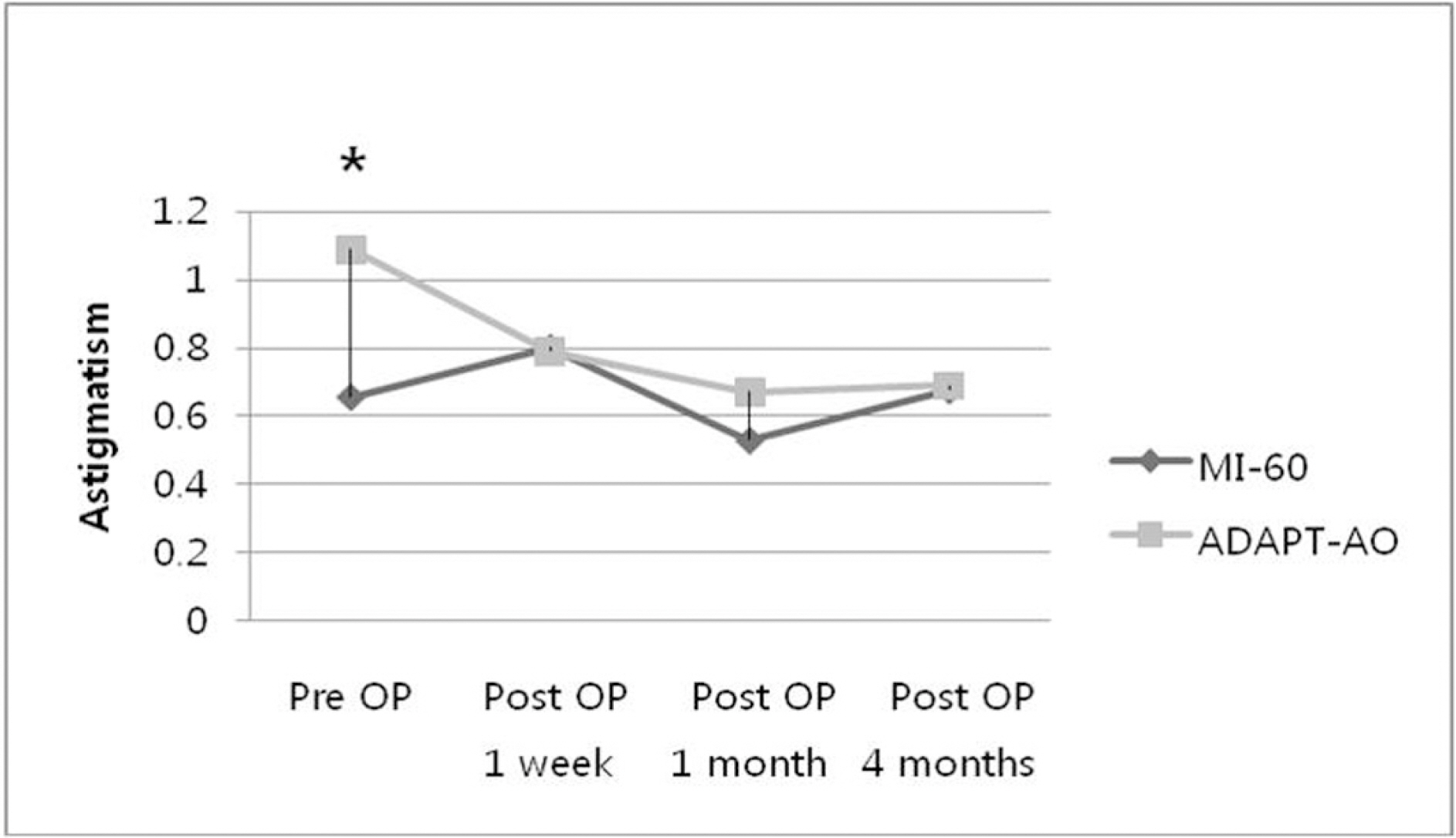J Korean Ophthalmol Soc.
2010 May;51(5):677-683.
Clinical Outcomes After Microincision Cataract Surgery and In-the-bag Implantation of a New Intraocular Lens
- Affiliations
-
- 1Department of Ophthalmology, Asan Medical Center, University of Ulsan College of Medicine, Seoul, Korea. HungTchah@amc.seoul.kr
Abstract
- PURPOSE
To compare visual performance after microincision cataract surgery (MICS) with the implantation of the Akreos MI-60 (MI-60) intraocular lens (IOL) through a 1.8-mm microincision with that after conventional cataract surgery with implantation of the Akreos Adapt-AO IOL (Adapt-AO).
METHODS
All MICS procedures were performed by the same surgeon. The MI-60 was implanted into 25 eyes, and the Adapt-AO was place in 28 eyes. Best corrected visual acuity (BCVA), total high-order-aberration (HOA), contrast sensitivity, and surgically- induced astigmatism (SIA) were recorded one-week, one-month, and four-months postoperatively.
RESULTS
There were no statistically significant differences in BCVA between eyes implanted with the MI-60 or those with the Adapt-AO (MI-60 vs. Adapt-AO, 0.09+/-0.11 at baseline (logMAR), 0.11+/-0.08 at one-week, 0.06+/-0.07, 0.06+/-0.06 at one-month, 0.05+/-0.06, 0.06+/-0.05 at four-months according to the Mann-Whitney U test, p>0.05). Refractive errors were significantly less with the Adapt-AO than with the MI-60 (MI-60 vs. Adapt-AO, -0.50+/-0.43 at baseline (diopter), -0.06+/-0.39 at one-week, -0.50+/-0.41, 0.01+/-0.57 at one-month, -0.46+/-0.36, 0.08+/-0.58 at four-months according to the Mann-Whitney U test, p<0.05). There were no statistically significant differences in total HOA or contrast sensitivity between eyes implanted with the MI-60 and those implanted with the Adapt-AO. SIAs were significantly reduced in eyes implanted with the MI-60 than in those with the Adapt-AO at one-month and four-months postoperatively (Mann-Whitney U test, p<0.05).
CONCLUSIONS
Implantation with either the MI-60 or the Adapt-AO produced clinically acceptable outcomes, including good spherical aberration and contrast sensitivity. Furthermore, implantation with the MI-60 caused less SIA at one- and four-months postoperation, as compared to that with the Adapt-AO.
Keyword
MeSH Terms
Figure
Reference
-
References
1. Ginsberg AP, Evans DW, Sekuler R, et al. Contrast sensitivity predicts pilots' performance in aircraft simulation. Am J Optom Physiol Opt. 1982; 59:105–9.2. Pesudovs K, Hazel CA, Doran RM, Elliot DB. The usefulness of Vistech and FACT contrast sensitivity charts for cataract and abdominal surgery outcomes research. Br J Ophthalmol. 2004; 88:11–6.3. Applegate RA, Hilmantel G, Howland HC, et al. Corneal surface abdominal aberrations and visual performance. J Refract Surg. 2000; 16:507–14.4. Mierdel P, Kaemmerer M, Mrochen M, et al. Ocular optical aberr-ometer for clinical use. J Biomed Opt. 2001; 6:200–4.
Article5. Bhattacharjee H, Bhattacharjee K, Medhi J. Visual performance: abdominal of foldable intraocular lenses. J Cataract Refract Surg. 2006; 32:451–5.6. Agarwal A, Agarwal A, Agarwal S, et al. Phakonit: phacoemulsification through a 0.9 mm corneal incision. J Cataract Refract Surg. 2001; 27:1548–52.
Article7. Agarwal A, Agarwal S. Phakonit with an AcriTec IOL. J Cataract Refract Surg. 2003; 29:854–5.
Article8. Fine IH, Hoffman RS, Packer M. Optimizing refractive lens exchange with bimanual microincision phacoemulsification. J Cataract Refract Surg. 2004; 30:550–4.
Article9. Braga-Mele R, Liu E. Feasibility of sleeveless bimanual abdominal with the Millenium microsurgical system. J Cataract Refract Surg. 2003; 29:2199–203.10. Mackool RJ. Temperature during bimanual phacoemulsification. J Cataract Refract Surg. 2004; 30:732.
Article11. Soscia W, Howard J, Olson R. Bimanual phacoemulsification through 2 stab incision a woundtemperature study. J Cataract Refract Surg. 2002; 28:1039–43.12. Soscia W, Howard JG, Olson RJ. Microphacoemulsification with WhiteStar. A woundtemperature study. J Cataract Refract Surg. 2002; 28:1044–6.13. Olson RJ. Clinical experience with 21-gauge manual microphacoemulsification using Sovereign Whitestar technology in eyes with dense cataract. J Cataract Refract Surg. 2004; 30:168–72.
Article14. Alio JL, Rodriguez Prats JL, Galal A. Advances in microincision abdominal surgery intraocular lenses. Curr Opin Ophthalmol. 2006; 17:80–93.15. Hill W. Expected effects of surgically induced astigmatism on AcrySof toric intraocular lens results. J Cataract Refract Surg. 2008; 34:364–7.
Article16. Donnenfeld ED, Olson RJ, Solomon R, et al. Efficacy and woundtemperature gradient of whitestar phacoemulsification through a 1.2 mm incision. J Cataract Refract Surg. 2003; 29:1097–100.
Article17. Steinert RF, Brint SF, White SM, et al. Astigmatism after small incision cataract surgery. A prospective, randomized, multicenter comparison of 4- and 6.5 mm incisions. Ophthalmology. 1991; 98:417–23.18. Alió JL, Piñero DP, Ortiz D, Montalbán R. Clinical outcomes and postoperative intraocular optical quality with a microincision aberration-free aspheric intraocular lens. J Cataract Refract Surg. 2009; 35:1548–54.
Article19. Tong N, He JC, Lu F, et al. Changes in corneal wavefront aberrations in microincision andsmall-incision cataract surgery. J Cataract Refract Surg. 2008; 34:2085–90.20. Denoyer A, Denoyer L, Marotte D, et al. Intraindividual comparative study of corneal and ocular wavefront aberrations after biaxial abdominal versus coaxial small-incision cataract surgery. Br J Ophthalmol. 2008; 92:1679–84.21. Wilczynski M, Supady E, Piotr L, et al. Comparison of surgically abdominal astigmatism after coaxial phacoemulsification through 1.8 mm microincision and bimanual phacoemulsification through 1.7 mm microincision. J Cataract Refract Surg. 2009; 35:1563–9.22. Milla E, Verges C, Cipres M. Corneal endothelium evaluation after phaocoemulsification with continuous anterior chamber infusion. Cornea. 2005; 24:278–82.23. Choi JA, Kim CY, Na KS, et al. Clinical results after implantation of a spherical aberration-free intraocular lens: Effect of contrast sensitivity and wavefront aberration-a clinical comparative study. Ophthalmologica. 2009; 223:320–5.
- Full Text Links
- Actions
-
Cited
- CITED
-
- Close
- Share
- Similar articles
-
- Clinical Results of Cataract Operations using Piggy-back Method
- Postoperative Refractive Errors after Phacovitrectomy with Sulcus Fixation of an Intraocular Lens
- Posterior Capsule Opacification and Intraocular Lens Design with In-the-bag fixated Posterior Chamber Lens
- A Clinical Results of Combined Vitrectomy, Cataract Extraction, and Posterior Chamber Intraocular Lens Implantation
- Posterior Chamber Intraocular Lens Implantation in High Myopia




